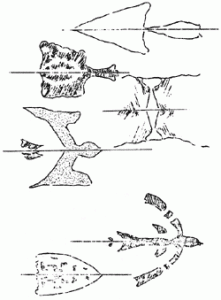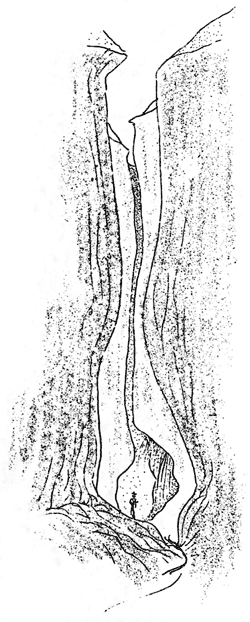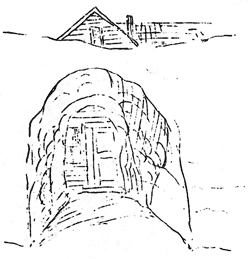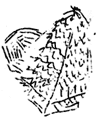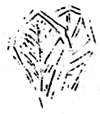 Volume 6 No. 2 – July 1, 1933
Volume 6 No. 2 – July 1, 1933
All material courtesy of the National Park Service. These publications can also be found at http://npshistory.com/
Nature Notes is produced by the National Park Service. © 1933.
The Snow Accumulation of 1907 Compared to that of 1933
By Earl W. Count, Ranger-Naturalist
“At Park Headquarters the snowfall for the winter measured 73 feet 3 inches, and the Rim Area probably received from 1/4 to 1/3 again as much.”
To which responds the “whew-w-w” of the visitor; whereupon the ranger adds in a loftily casual manner, “Yes, we are getting back to normal.”
In the Information Bureau there hangs a picture of the party given on Victor Rock in honor of Secretary of the Interior James Garfield. The date is July 18, 1907. On July 12, 1933, several ranger-naturalists compared the background of this picture with the current conditions. Patch for patch the snowfields were very readily identified on Mt. Scott and Garfield Peak. And immediately it became obvious that on July 18, 1907 more snow remained on the slopes than still existed on July 12, 1933.
How Fast is the Rim Retreating?
By Earl W. Count
Immediately behind the group in the photograph stand three trees close together. But today they are gone. The stump of one now projects over the rim of the funnel-like amphitheater immediately east of the Information Bureau. According to Judge Steel, the present U. S. Commissioner and affectionately called “The Father of Crater Lake”, who gave the party on that day in 1907, there was at that time ten feet more of rim, as well as the now vanished three trees.
At the head of this amphitheater the rim area itself is depressed, so that melting snow from the rim drains off over the amphitheater-shaped rim slope. The concentration of this water into several streamlets affords those frequent landslides at this time which attract the attention of visitors and cause them to lean out over the parapet at the Sinnott Memorial. So works the relentless erosive forces of Nature gradually accomplishing the recession of the rim of Crater Lake. Undoubtedly it is this unevenness in the distribution of morainal material over the rim area that accounts for the formation of the amphitheater in the first place. In the course of the ages to come, probably such amphitheaters as this will father the development of steep, V-shaped valleys converging upon a shallower “Crater Lake”; and that lake of the future will occupy but the center of a much broader, shallower basin-valley than the rugged precipices of Crater Lake now enclose.
The Lake and Moods of May
By David LeC. Evans, Ranger-Naturalist
March, it is said, comes in like a lion and departs like a lamb, but at Crater this year it has continued like the proverbial lion until the last few days of may. These last few days have brought out the fact that nowhere can spring be more glorious than up here above the snowline.
This combination of perdition and heaven, climatically speaking, has revealed the lake in two very distinctive moods. The numerous unfortunates who arrived before this return of spring were lucky to see the lake at all, for as it snowed and rained, banks of vapor and cloud were whipped down into the huge caldron, hiding from view the then turbulent waters of the lake. Let us consider the description of this phase sufficient, despite its briefness. It is the stormy and disappointing mood.
On the other had, those fortunate who have been viewing the lake during this last week of May, have departed with a picture never to be forgotten. Standing on the top of a fifteen foot snowbank, they gaze, in the brilliant sunlight, into a gigantic blue mirror, set in sloping frame of glistening white, spotted with tints of green, red and brown. There are two Wizard Islands, a duo of Hillman Peaks, massive Llao Rock stands majestically, capped with a white, musing over its reflection in the blue waters at its base. Not a breath of air stirs, and all is silence except for the distant ‘swish’ of sliding snow. Only on such a day could Joaquin Miller have called this the “Silent Sea”.
As interesting as the lake, itself, are the snowbanks at the water’s edge and their reflections. It takes little imagination to see that the base of Dutton Cliff a series of very ornate arrows, unfortunately, not pointing towards true north but due east…..
A perfect butterfly of the swallow tail variety, perfect in every detail, spends the entire day, floating easterly below Cloudcap, but is ever stationary…..
Our Wineglass of the eastern end of the lake stand erect, and then “bottoms up” on the blue-clothed table…..
For a person of geological mind, the imagination runs rife. A great creature of the Mesozoic period is seen flying south, an Ichthyosaur (what a name!) with a triangular head and great expanse of wing.
A gigantic fish of ancient vintage (Paleozoic) pursues friend Pterosaur, but can never cut down that constant gap that separates them…..
The ornate arrows suggest the early Indian visitors to Crater Lake, as does the upper half of a war shield of very intricate and detailed design.
In conclusion, such stillness leas to that common question, “What, the lake is never coated over with ice? How very strange,” Invariably the answer is concluded “- – – but occasionally there is a slush ice.” We could give as the reason for this lack of ice two factors: (1) In a deep lake the later at the surface, as it approaches the freezing point become heavier and sinks. The warmer water beneath rises and this continuous vertical circulation assists in preventing the formation of ice at the surface; and (2) the ever present winter storms keep the surface in such a state of agitation, that ice cannot form. This last week in may has made the latter pint a strong one, for during this cold week, still weather, a definite slush ice has been observed on the surface, in the early morning.
Red Snow
By E. L. Clark, Ranger Naturalist
The blood-red snow fields of the Arctic, the red snow storms of tradition, and the red snows of the high Cordillera have made their appearance at Crater Lake.
On July 3 pink splotches on the snow covering the pumice flat in front of the Lodge. July 5 similar areas were noted on the snow partially blanketing the lava flows near the Witch’s Pool on Wizard Island. July 8 the phenomena was noted on the high slopes of Castle Crest, the western portion of Garfield Peak.
Scraping away the upper portions of these pink splotches, one finds the coloration intensified. A great abundance of tiny red spheres will be fond as the coloring matter when examined under a high magnification. These red spherical masses are algae, known to scientists as Protococcus nivalis, meaning earliest snow-dwelling plant.
Llao’s Hallway
By Warren G. Moody, Park Ranger
A hallway cannot always be in the best of trim to receive visitors, especially one which between seasons is being altered or decorated by Nature herself. And so at the present time Llao’s Hallway is undergoing a rigorous housecleaning and will not be in condition to receive visitors in any hospitable manner for a week or more.
The elements are at work throwing off the winter cloak from Llao’s Hallway in a most unique manner. It must necessarily take a little time to accomplish this due to the structural material of this hallway and to the unorthodox design of its passageways. Llao’s Hallway lies beneath the vortex of the V-shaped gorge, formed as White Horse Creek has eroded away a vast amount of pumice just before joining Castle Creek in its rush toward Rogue River. Ordinarily a stream flows in the bottom of the “V” of such a canyon but this stream behaves in a ravenous manner, eating deeply through the loose formation from the freshets of spring, before it dries up for the summer. The erosion due to the stream makes inroads into the earth with which the weathering on the sides of the gorge cannot keep pace. In many places this underground cutting is wider at the base than it is overhead, thus giving the appearance of a cavernous hallway. As the stream approaches its erosive level at the junction with Castle Creek it takes a more winding course and there is erosion horizontally as well as vertically. As a result the walls of Llao’s Hallway are quite artistically arched in these lower reaches.
Winter snows still linger in places at the bottom of this gore and offer serious impediment to the progress of the inquisitive visitor. The first point of difficulty is reached about halfway down and is due to an overhanging block of packed snow, about seven feet thick, caught in the narrow part of the gorge so that the stream runs some five or six feet beneath it. The sheer ends of this block of snow make it impossible to climb over the top if it even if there were no danger of its caving in. Strangely enough this snowpack melts almost entirely from the underside for the top becomes covered with the loosened soil particles from the weathering slopes above. This soil layer is a poor conductor of heat and acts as an insulator to keep the heat of the sun’s rays from reaching the snow from the top. In a few days there will be enough melted snow from the underside to allow the remainder of this block to drop and be carried away or melted by the waters of the running stream now rambling so gaily beneath it. Then it will be that the intrepid explorer who dons some waterproof boots and an extra ounce of nerve, will find delight in delving into the mysteries of Llao’s Hallway. Many vivid and lasting impressions are to be gained from this example of handiwork which Nature is in the process of making here in Crater Lake National Park.
Time Change
By Bernie Hughes, Ranger
Charity liked people and sometimes was regarded as an unofficial greeter during the 1932 season, welcoming visitors to Crater Lake National Park. With all the dignity possessed by a two-year bear, she would station herself along the Western Entrance Road and await the arrival of motorists. During the early part of each morning and the later hours of the afternoon, she would sit on the pavement begging for food.
Charity had a successful season. She was never hungry when nightfall overtook labors of the day. With the arrival of the morning sun she would again take her position, and became a familiar figure along the road.
Charity remembers 1932 as a perfect season, but with the arrival of 1933 and spring, new conditions faced her. She had become a mother of three cubs, adding greater responsibilities in the quest for food. No longer does she linger at any certain place along the highway, but has taken up patrolling seriously.
She and the cubs have been seen from Whiskey Creek, outside of the park, to Government Camp, a distance of approximately 12 miles, ranging through the woods during all hours of the day. At times when she and her offsprings wandered by Annie Springs, she caused checking rangers considerable grief and consternation by her insistence on obtaining foodstuffs. She has been known to climb into parked autos on her food forays. Despite her attempts to be “lady-like”, she has been often crude, but always a bear.
An Arctic Approach
By R. P. Andrews, Park Ranger
“Oh, isn’t that the cutest thing! Stand over there, Junior, and let me take a picture of you”. Thus at least thirty times a day would park visitors rhapsodize during the first two weeks I checked cars at Annie Springs. Although “cute” was hardly the adjective to apply to an eighteen foot wall of snow — which is what it measured on April 23 — picturesque it certainly was. When it first attracted the attention of large numbers of people, on the day of the Medford opening, the snow wall, thrown by the plow, almost completely covered the Annie Springs cabin, one tiny portion of gable being perceptible. The tunnel leading to the front door had not yet been completely cut through — a feature which somewhat added to its mystery causing visitors to peer into the ice cave and wonder just what, if any, its purpose was.
When I first went on duty at Annie Springs for the summer on June 15, the aperture had widened so that five or six people might stand in it at once; the wall of snow had melted and flattened so that, instead of a flagpole surmounting a glacier, one could see the peaked roof of the log cabin. From then on it melted rapidly from both sides. The roof of the cave became thinner and narrower, and once could see the light shining through it during the last few days. On hot days visitors would rush into this cool retreat, exclaiming over the color of the walls. They were an icy blue-green, and the rough surface made them look as if they had been hewn out with an adze.
Once a mother bear with three small cubs essayed to climb the dizzy heights on top, in a vain search for food. A crowd at the checking station stood breathless as the old lady ambled over the span, the three cubs following in single file. Would it hold them up, or would they crash through? At this crucial point, a man came out of the front door, and through the tunnel. Much to his amazement, he was greeted with gales of laughter. He did not realize that to the others it looked like a game of “Heavy, heavy hangs over thy head.” Finally, the bear family, in disgust, wandered away, and our tunnel remained intact. Several rangers showed signs of disgust, too. It had been the picture of the year, and nobody at Annie Springs could find a camera.
By the twenty-eighth of June the four-foot span had narrowed and thinned until it was no more than six inches wide and less than half that in thickness. I knew it could not last much longer, and I kept glancing over that way, hoping to see the final cave-in. But I was not to be so fortunate. In the midst of checking over the travel figures, I heard a soft “plop”. Without ceremony, and with no audience, the Annie Springs snow tunnel had fallen in.
Rare Crystal of Specular Hematite Found at Crater Lake
By D. S. Libbey
Although John Wesley Hillman and the party of prospectors searching for the fabled Lost Cabin Mine in 1853 did not find valuable gold ores in the vicinity of Crater Lake, it is now known that very unique metal deposits are well hidden under the pumice slopes of old Mt. Mazama. Last fall an excavation along the new highway to the North Boundary unearthed the entrance to a cavern on the northwest shoulder of Llao Rock.
When the cavern was explored many tortuous passageways were found in the slaggy, acicular lava rock. Spicules of dacite made the exploration of the intricate passageways extremely difficult. On every side spikes of glassy lava rock protruded and in many recesses in the rough surface there was found delicate crystal flakes of specular hematite. One side of the crystal flakes possessed a splendent metallic lustre, while the other was dull, iron black to dark steel gray in color. Only crystal fragments were discovered which showed the symmetry of the hexagonal system.
Specular hematite in a minute flake form is found in volcanic regions. It occurs as a result of iron in a highly incandescent state being volatized and as a fumerolic emanation passing through the air passages with condensation resulting and flake crystals developing. This discovery conclusively shows that while gases were still issuing from the old mountain such material found its way out through the various porous formations in the radiating slopes. The mineral deposits found are of no economic value but are of vast interest to the scientist interested in unraveling the events which occurred in the past.
Random Notes
By Albert E. Long, Ranger Naturalist
A Raven dropping its prey, a golden mantled ground squirrel, in order to escape an approaching auto between high banks of snow.
Tree roots inside small lava tubes and by the expansive force of continued growth, finally breaking open the tube.
A rare blanket of fog on the surface of the lake, with Wizard Island still partly visible, makes the crater appear to be a sea of clouds.
Sliding on the packed snow into the crater of Wizard Island seems to be the most popular sport of the groups visiting Wizard Island. Some find the snow wet, but none complain — it’s all good fun.
Other pages in this section

